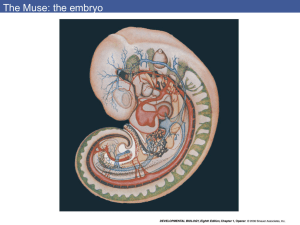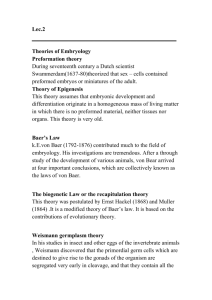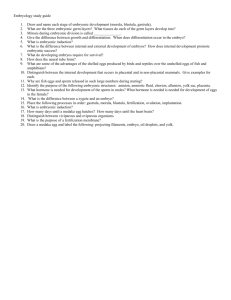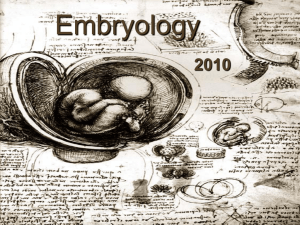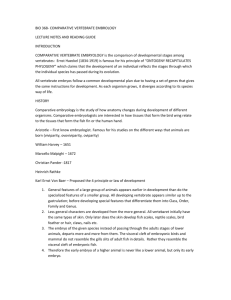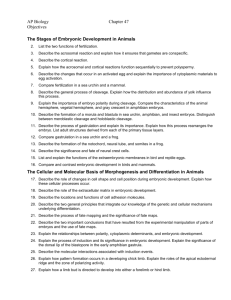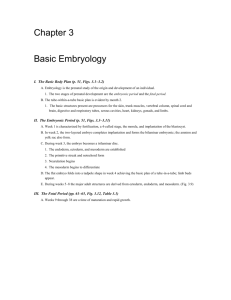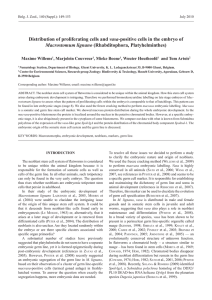L02 Developmental Anatomy
advertisement
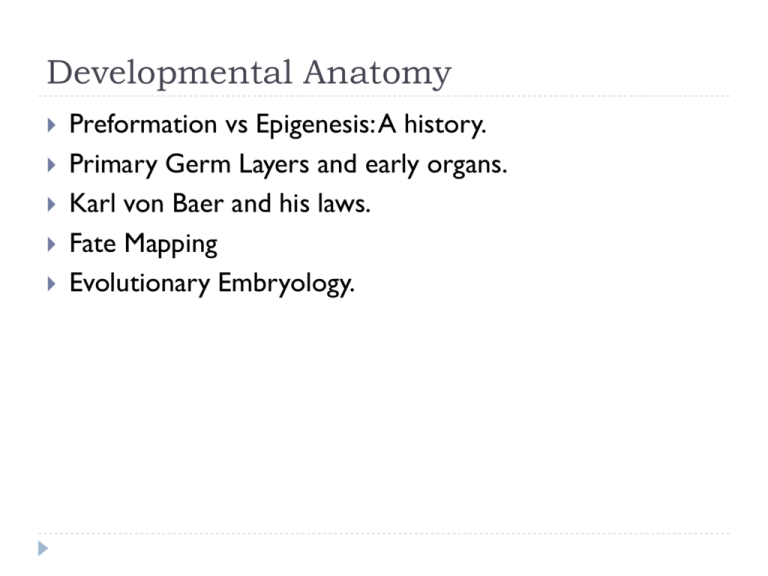
Developmental Anatomy Preformation vs Epigenesis: A history. Primary Germ Layers and early organs. Karl von Baer and his laws. Fate Mapping Evolutionary Embryology. Aristotle: First biologist? The Generation of Animals (350 BCE) Noted Variations of life cycle themes: Some born of Eggs (oviparity) Some from live birth (viviparity) Some from eggs, but hatch in mother (ovoviviparity). Holoblastic- whole egg divided into smaller cells Meroblastic- half egg divides into smaller cells; rest is yolk sac. Cell Division differs amongst species Ex ovo omnia- Willaim Harvey 1651 Preformation Belief that everything is in egg and/or sperm in smaller form. Overtime, organs and essentially the organism grows. Marcello Malphigi- studies chick embryos..notes abundance of structure in embryo and questions epigenesis Predates cell theory Epigenesis Embryonic parts arise from embryonic tissue. Newly formed organs. Kasper Friedrich Wolff provides evidence that embryonic organs arise from tissue that has no adult counter part! Sets the foundation for Germ layer theory. “Developmental Force” Immanuel Kant and Johann Friedrich Blumenbach (mid to late 1700s). Mystical force leads to development of embryos. This “force” is heritable from germ cells and highly susceptible to change. Mendel’s work almost a century later… Developmental force= Genetics? Using the microscope revolutionizes development Christian Pander, Heinrich Rathke, and Karl Ernst von Baer. Identify the three germ layers: Ectoderm Mesoderm Endoderm The Three Germ Layers Triploblastic and diploblastic Organisms These organisms use all three germ layers. Some organisms only use two germ layers (lack mesoderm): Porifera (sponges) Cnidarians (sea anemones, hydra, jellyfish) Ctenophores (comb jellies) Axes and Symmetry Christian Pander Work with Chick Embryos. Supports epigenesis by showing that tissues worked together to form organs. Discovers tissue interaction-Induction: No tissue can form organs alone, must interact with other tissues in order to for organogenesis to occur. Heinrich Rathke Discovered pharyngeal arches. In fish, these arches give rise to gill apparatus In humans, form jaw, ears, vertebrate skull. Karl Ernst von Baer “Father” of Developmental Biology Expanded Pander’s studies of Chick Embryos. Identifies notochord- rod of dorsal-most mesoderm tissue. Notochord divides embryo in right and left sides, instructs ectoderm above it to differentiate into nerve tissue. von Baer laws Rule 1:The general features of a large group of animals appear earlier in development than do the specialized features of a smaller group. All vertebrates have similar structures during development: gill arches, notochord, primitive kidneys. Very similar shortly after gastrulation. von Baer’s laws Rule 2: Less General characters are developed from the more general, until finally the most specialized appear. All vertebrates have skin, later skin becomes feathers for birds, scales for reptiles, hair and nails for mammals von Baer’s Laws Rule 3: The embryo of a given species, instead of passing through the adult stages of lower animals, departs more and more from them. Visceral clefts of embryonic birds/mammals do not ressemble gill slits of adult fish. von Baer’s Laws Rule 4: Therefore, the early embryo of a higher animal is never like a lower animal, but only like its early embryo. We never pass through a developmental stage similar to adult fish or birds. Are there really similarities? The Cell theory and Fate mapping Matthias Schleiden and Theodor Schwann in 1838 formalize the Cell theory: all living organisms are composed of cells! Embryologists followed this movement and began tracking cell movement during development! Two Cell types: Epithelial and Mesenchymal Epithelial Mesenchymal Morphogenesis Direction and No. of cell divisions Cell shape changes Cell movement Cell growth Cell death. Cell Movement and association Cadherin based adhesion-self association. Different strength of interaction Morphogenesis How do you fate map cells? Observing live embryos! Edwin G Conklin Still used as primary fate mapping technique. Zebra Fish will allow you to do this! How do you fate map cells? Vital Dye Marking Vital dyes stain the cells but don’t kill them. Dead cells tell no tales…unless you study apoptosis. How do you fate map cells? Radioactive/ Fluorescent labeling Radioactive label: Transplant of graft from radiolabeled embryo to unlabeled embryo. Silver stain! Fluorescent labeling: Inject fluorescent dye into cells of embryo. How do you fate map cells? Genetics! Use cells from another organism that contain a easily detectable marker! Darwin: Embryology’s biggest fan! Saw Embryology as support for his theories. “Community of embryonic structure reveals community of descent” This is shown in Homologous structures, such as the forelimb of human arms vs. wings of a bird! What would be an analogous structure? Evolutionary change is due to developmental change.. Ontogeny causes phylogeny? Human fingers versus Bat wing!
